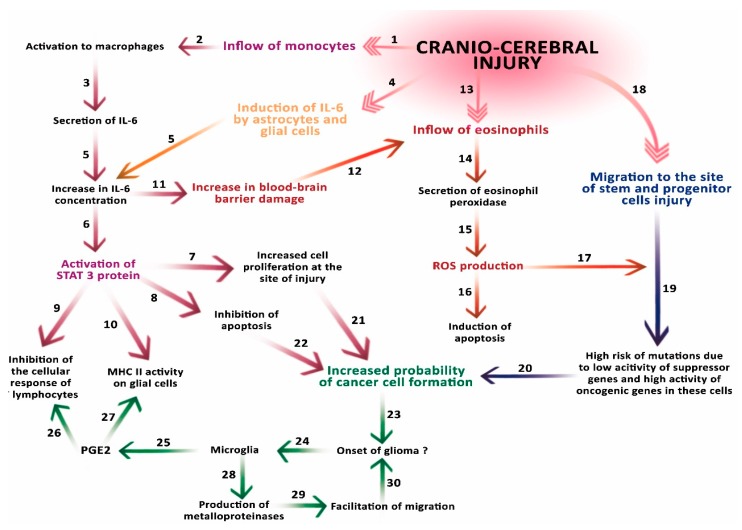Figure 2.
Schematic representation of the involvement of carcinogenic factors after cerebral injury. An injury causes the influx of monocytes to the site of damage (1), where they are activated to macrophages (2) that produce interleukin 6 (IL-6) (3). The injury also induces enhanced IL-6 secretion by astrocytes and microglial cells (4). Together, these processes cause a significant increase in IL-6 concentration (5). The increased concentration of IL-6 activates STAT3 (6), which increases cell proliferation at the site of injury (7) and inhibition of apoptosis (8). STAT3 inhibits the activity of T cells (LcT) and (9) decreases the activity of major histocompatibility complex (MHC) particles on cells of the immune system and glial cells (10). The increase in IL-6 concentration also affects the blood–brain barrier (BBB) (11), facilitating the penetration by eosinophils (12) flowing to the site of injury (13). The eosinophils, which flow through the damaged barrier, secrete eosinophil peroxidase, which generates reactive oxygen species (ROS). ROS contribute to the induction of apoptosis (16), but may also contribute to the formation of mutations (17) in stem and progenitor cells that migrate to the site of injury (18). Low activity of suppressor genes in these cells and high activity of oncogenic genes may additionally increase the risk of mutations (19). The risk of these mutations (20), an increase in cell proliferation at the site of injury (21) and the inhibition of apoptosis (22) may jointly contribute to the formation of a cancer cell, and start the process of carcinogenesis (23). The glioma resulting from these processes affects microglia (24), which secrete PGE2 (25), increasing the inhibition of LcT activity (26) and causing a decrease in MHC molecules activity on cells of the immune system and glial cells (27). In addition, microglia secrete metalloproteinases (28) in the tissues adjacent to the tumor, facilitating its migration (29) and thus facilitating its development (30).

